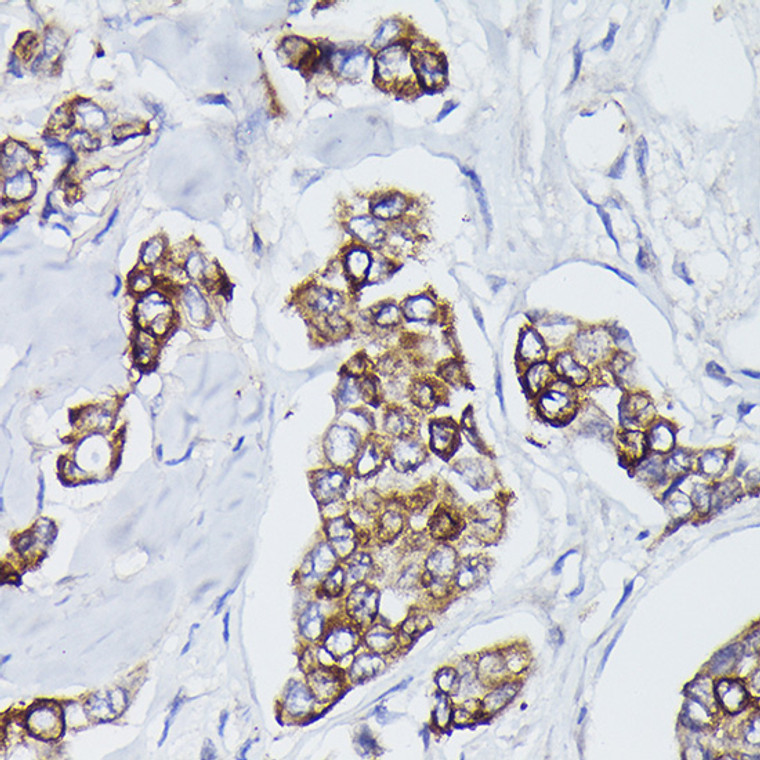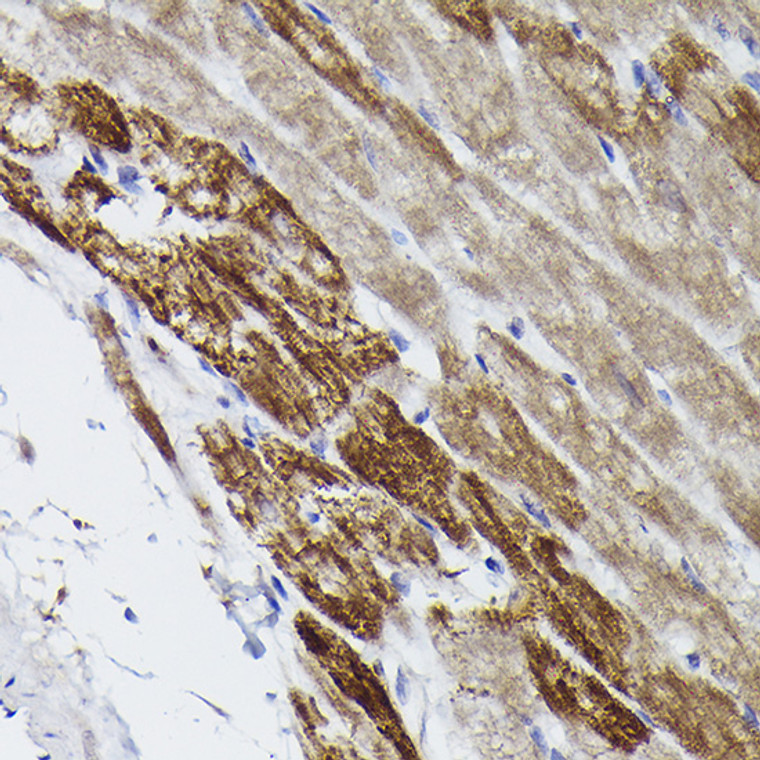| Host: |
Rabbit |
| Applications: |
WB/IF |
| Reactivity: |
Human/Mouse/Rat |
| Note: |
STRICTLY FOR FURTHER SCIENTIFIC RESEARCH USE ONLY (RUO). MUST NOT TO BE USED IN DIAGNOSTIC OR THERAPEUTIC APPLICATIONS. |
| Short Description: |
Rabbit polyclonal antibody anti-PINK1 (143-581) is suitable for use in Western Blot and Immunofluorescence research applications. |
| Clonality: |
Polyclonal |
| Conjugation: |
Unconjugated |
| Isotype: |
IgG |
| Formulation: |
PBS with 0.05% Proclin300, 50% Glycerol, pH7.3. |
| Purification: |
Affinity purification |
| Dilution Range: |
WB 1:500-1:1000IF/ICC 1:50-1:200 |
| Storage Instruction: |
Store at-20°C for up to 1 year from the date of receipt, and avoid repeat freeze-thaw cycles. |
| Gene Symbol: |
PINK1 |
| Gene ID: |
65018 |
| Uniprot ID: |
PINK1_HUMAN |
| Immunogen Region: |
143-581 |
| Immunogen: |
Recombinant fusion protein containing a sequence corresponding to amino acids 143-581 of human PINK1 (NP_115785.1). |
| Immunogen Sequence: |
LDTRRLQGFRLEEYLIGQSI GKGCSAAVYEATMPTLPQNL EVTKSTGLLPGRGPGTSAPG EGQERAPGAPAFPLAIKMMW NISAGSSSEAILNTMSQELV PASRVALAGEYGAVTYRKSK RGPKQLAPHPNIIRVLRAFT SSVPLLPGALVDYPDVLPSR LHPEGLGHGRTLFLVMKNYP CTLRQYLCVNTPSPRLAAMM LLQLLEGVDHLVQQGIAHRD LKSDNILVELDPDGCPWLV |
| Tissue Specificity | Highly expressed in heart, skeletal muscle and testis, and at lower levels in brain, placenta, liver, kidney, pancreas, prostate, ovary and small intestine. Present in the embryonic testis from an early stage of development. |
| Post Translational Modifications | Proteolytically cleaved. In healthy cells, the precursor is continuously imported into the inner mitochondrial membrane (IMM), where it is proteolytically cleaved by mitochondrial-processing peptidase (MPP) and then undergoes further proteolytic cleavage by PARL or AFG3L2 to give rise to the 52 kDa short form. The 52 kDa short form is then released into the cytosol where it rapidly undergoes proteasome-dependent degradation. In unhealthy cells, when cellular stress conditions lead to the loss of mitochondrial membrane potential, mitochondrial import is impaired leading to the precursor accumulating on the outer mitochondrial membrane (OMM). If accumulation at the OMM fails and it is imported into the depolarized mitochondria, it undergoes cleavage by the IMM protease OMA1, promoting its subsequent degradation by the proteasome. Autophosphorylated. Loss of mitochondrial membrane potential results in the precursor accumulating on the outer mitochondrial membrane (OMM) where it is activated by autophosphorylation. Autophosphorylation at Ser-228 and Ser-402 is sufficient and essential for selective recruitment of PRKN to depolarized mitochondria, via PINK1-dependent phosphorylation of ubiquitin and maybe PRKN. |
| Function | Serine/threonine-protein kinase which protects against mitochondrial dysfunction during cellular stress by phosphorylating mitochondrial proteins such as PRKN and DNM1L, to coordinate mitochondrial quality control mechanisms that remove and replace dysfunctional mitochondrial components. Depending on the severity of mitochondrial damage and/or dysfunction, activity ranges from preventing apoptosis and stimulating mitochondrial biogenesis to regulating mitochondrial dynamics and eliminating severely damaged mitochondria via mitophagy. Mediates the translocation and activation of PRKN at the outer membrane (OMM) of dysfunctional/depolarized mitochondria. At the OMM of damaged mitochondria, phosphorylates pre-existing polyubiquitin chains at 'Ser-65', the PINK1-phosphorylated polyubiquitin then recruits PRKN from the cytosol to the OMM where PRKN is fully activated by phosphorylation at 'Ser-65' by PINK1. In damaged mitochondria, mediates the decision between mitophagy or preventing apoptosis by promoting PRKN-dependent poly- or monoubiquitination of VDAC1.polyubiquitination of VDAC1 by PRKN promotes mitophagy, while monoubiquitination of VDAC1 by PRKN decreases mitochondrial calcium influx which ultimately inhibits apoptosis. When cellular stress results in irreversible mitochondrial damage, functions with PRKN to promote clearance of damaged mitochondria via selective autophagy (mitophagy). The PINK1-PRKN pathway also promotes fission of damaged mitochondria by phosphorylating and thus promoting the PRKN-dependent degradation of mitochondrial proteins involved in fission such as MFN2. This prevents the refusion of unhealthy mitochondria with the mitochondrial network or initiates mitochondrial fragmentation facilitating their later engulfment by autophagosomes. Also promotes mitochondrial fission independently of PRKN and ATG7-mediated mitophagy, via the phosphorylation and activation of DNM1L. Regulates motility of damaged mitochondria by promoting the ubiquitination and subsequent degradation of MIRO1 and MIRO2.in motor neurons, this likely inhibits mitochondrial intracellular anterograde transport along the axons which probably increases the chance of the mitochondria undergoing mitophagy in the soma. Required for ubiquinone reduction by mitochondrial complex I by mediating phosphorylation of complex I subunit NDUFA10. Phosphorylates LETM1, positively regulating its mitochondrial calcium transport activity. |
| Protein Name | Serine/Threonine-Protein Kinase Pink1 - MitochondrialBrpkPten-Induced Putative Kinase Protein 1 |
| Database Links | Reactome: R-HSA-5205685Reactome: R-HSA-9614657 |
| Cellular Localisation | Mitochondrion Outer MembraneSingle-Pass Membrane ProteinMitochondrion Inner MembraneCytoplasmCytosolLocalizes Mostly In Mitochondrion And The Two Smaller Proteolytic Processed Fragments Localize Mainly In CytosolWhen Mitochondria Lose Mitochondrial Membrane Potential Following DamagePink1 Import Is ArrestedWhich Induces Its Accumulation In The Outer Mitochondrial MembraneWhere It Acquires Kinase Activity |
| Alternative Antibody Names | Anti-Serine/Threonine-Protein Kinase Pink1 - Mitochondrial antibodyAnti-Brpk antibodyAnti-Pten-Induced Putative Kinase Protein 1 antibodyAnti-PINK1 antibody |
Information sourced from Uniprot.org
12 months for antibodies. 6 months for ELISA Kits. Please see website T&Cs for further guidance














